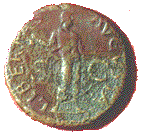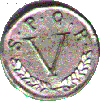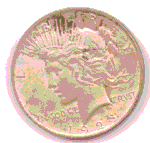






| Denomination |
Metal |
Weight |
Equvelent value-in Denari |
Equvelent value- In Asses |
| Aureus |
gold |
7.9 grs. |
25 |
400 |
| Quinarius |
gold |
3.8 grs. |
12-1/2 |
200 |
| Denarius |
silver |
3.8 |
1 |
16 |
| Quinarius |
silver |
1.9 grs. |
1/2 |
8 |
| Sestertius |
Orichalcum |
25 grs. |
1/4 |
4 |
| Dupondius |
Orichalcum |
12.5 grs. |
1/8 |
2 |
| As |
copper |
11 grs. |
1/16 |
1 |
| Semis (introduced by nero 64-68 A.D. |
Orchalcum |
3.25 grs |
1/32 |
1/2 |
| Quadrans |
copper |
3 grs |
1/64 |
1/4 |